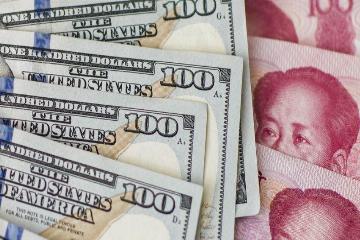Rising External Risks Boost Appeal of Chinese Assets
Advertisements
The global economy is currently grappling with a plethora of uncertainties, escalating with the latest developments in U.S.-China trade relationsOn April 14, the U.S. government announced an increase in tariffs on Chinese electric vehicles and several other productsIn a parallel announcement, Jerome Powell, Chair of the Federal Reserve, expressed his doubts about inflation easing in the near future, with Fed Governor Christopher Waller including statements suggesting that there would be no interest rate cuts in 2023.
Interestingly, despite these economic shifts, the Chinese yuan saw a significant appreciationBy April 15, the onshore yuan surged dramatically, closing up 182 points against the U.S. dollarMeanwhile, Hong Kong's Hang Seng Index dipped 0.22% to close at 19,073.71 points, and the Shanghai Composite Index fell by 0.82%, remaining above the critical threshold of 3,100 points
Later that evening, following the release of the U.SConsumer Price Index (CPI) for April, which did not show an unexpected uptick, the dollar index declined sharply, with the dollar sinking over 300 points against the offshore yuan at one point.
The broader consensus among analysts is that the effects of the tariff increases are limitedThe total impact on China's exports is considered relatively modest, affecting approximately $18 billion worth of products, which only accounts for about 4.2% of total U.S. imports from China and less than 1% of China's overall exportsMoreover, since certain tariffs may not take effect until 2025 or 2026, exporters may likely accelerate shipments to avoid being impacted by the new tariffs, mirroring behaviors observed in 2018 and 2019.
The U.S. market doesn't heavily rely on China's electric vehicle exports, with only around 10,000 fully electric vehicles exported to the U.S. in 2022, worth less than $460 million
- Powell Comments on Preliminary Nonfarm Payroll Data
- U.S. Jobs Report Signals Economic Weakness
- Challenges in Identifying Risks Amid Declining Inventory
- Strategies to Boost Domestic Demand
- Shanghai Stock Exchange Expands REITs Trading
Compared to other countries, China's share of U.S. imported electric vehicles is a mere 2%, which is significantly overshadowed by Germany, South Korea, and Japan.
According to Liu Yang, a foreign exchange expert and a finance market manager, the actual impact of the increased tariffs is marginal and was anticipated by market playersThe announcement had already been factored into the market sentiment, and now that it has actualized, it may result in the relief of downward pressures.
The rising yuan continued to gather momentum on April 15, closing at 7.2195 against the dollarThe offshore yuan also improved significantly, reflecting stronger underlying market conditionsIn the aftermath of Powell's recent hawkish hints, the dollar index demonstrated weakness, drifting down to approximately 104.7 after nearing 106 previously.
The U.SCPI report released later that evening showed an annual increase of 3.4%, aligning with expectations but slightly easing from the prior month
This led to an immediate drop in the dollar index, reaching its lowest point since early April, partly contributing to speculation around potential future interest rate cuts by the Federal ReserveThe market is currently betting on only a modest rate cut later in the year, with many analysts anticipating a 35 basis point reduction rather than the initially expected six to seven cuts.
Despite enduring strong dollar pressures, the recent stabilization of various Chinese economic indicators appears to be fostering a return of international capital to Chinese markets, helping to support the yuanThe People's Bank of China (PBoC) has also demonstrated a keenness to maintain currency stability, with the midpoint exchange rate adjustment for the yuan showing significant strength at over a thousand points since April began.
Analysts emphasize that the enhancement of the economic fundamentals is pivotal
Recent data on China's exports, inflation, and social financing revealed a positive trendThe export growth has returned to positive territory, benefiting from global recovery effortsFurthermore, China has been refreshing policies in its real estate sector to improve market sentimentChanges include facilitating ‘old-for-new’ exchange programs and relaxing housing purchase restrictions, which are factors attracting foreign investments.
Significantly, the relationship between the yuan and the yen is becoming increasingly relevant, as financial experts are noticing that the yuan is gradually being seen as a financing currencyThis shift is occurring under the backdrop of China's diminishing interest rates compared to traditional high-yielding currencies like the U.S. dollar, rendering the yuan ever more appealing in triangular currency trades.
With Japan long adopting a low-interest rate policy, the yen has been a go-to financing currency for traders who borrow yen to invest in higher yielding assets like the dollar

Analysts note that recent trends in the yuan and yen have closely mirrored each other more than in past years, signaling investors' adaptability in their currency strategies, particularly in response to Federal Reserve policies and the volatility of the dollar.
Amid these dynamics, the Japanese yen recently saw fluctuations around 155 to the dollarThe Bank of Japan made headlines by reducing its bond purchases for the first time, which has been interpreted as a form of currency supportThis adjustment coincided with rising yields in the Japanese bond market and a corresponding rise in yen valuation against the dollar.
Looking at the stock market, the impact of external risks on A-shares and Hong Kong stocks appears to be limitedAs of April 15, no trading occurred for northbound capital in Hong Kong due to a public holidayHowever, there has been a substantial net inflow of capital this year, showing a strong reliance on foreign hedge and quantitative funds bolstering purchases in the Hong Kong market.
The Hang Seng Index just breached the 19,000-point psychological threshold, illustrating a significant rebound of over 25% since late January, marking a technical bull market
Leave a Comment